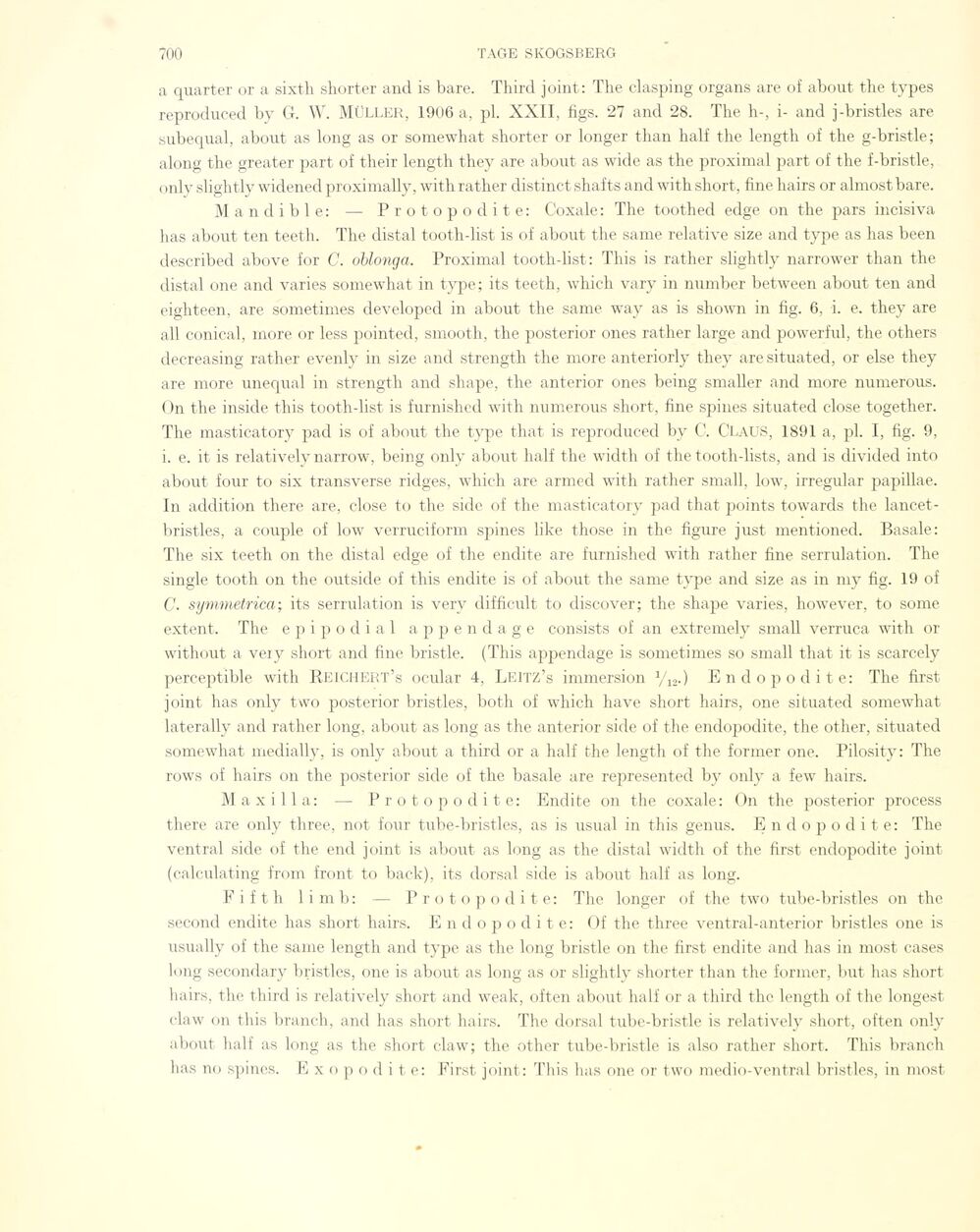
Full resolution (JPEG) - On this page / på denna sida - Sidor ...

<< prev. page << föreg. sida << >> nästa sida >> next page >>
Below is the raw OCR text
from the above scanned image.
Do you see an error? Proofread the page now!
Här nedan syns maskintolkade texten från faksimilbilden ovan.
Ser du något fel? Korrekturläs sidan nu!
This page has never been proofread. / Denna sida har aldrig korrekturlästs.
a quarter or a sixtli shorter and is bare. Third joint: The clasping organs are of about the types
reproduced by G. W. MÜLLER, 1906 a, pi. XXII, figs. 27 and 28. The h-, i- and j-bristles are
subequal, about as long as or somewhat shorter or longer than half the length of the g-bristle;
along the greater part of their length they are about as wide as the proximal part of the f-bristle,
only slightly widened proxi mally, with rather distinct shafts and with short, fine hairs or almost bare.
Mandible: — Protopodite: Coxale: The toothed edge on the pars incisiva
has about ten teeth. The distal tooth-list is of about the same relative size and type as has been
described above for C. oblonga. Proximal tooth-list: This is rather slightly narrower than the
distal one and varies somewhat in type ; its teeth, which vary in number between about ten and
eighteen, are sometimes developed in about the same way as is shown in fig. 6. i. e. they are
all conical, more or less pointed, smooth, the posterior ones rather large and powerful, the others
decreasing rather evenly in size and strength the more anteriorly they aresituated, or else they
are more unequal in strength and shape, the anterior ones being smaller and more numerous.
On the inside this tooth-list is furnished with numerous short, fine spines situated close together.
The masticatory pad is of about the type that is reproduced by C. Claus, 1891 a, pl. I, fig. 9,
i. e. it is relatively narrow, being only about half the width of the tooth-lists, and is divided into
about four to six transverse ridges, which are armed with rather small, low, irregulär papillae.
In addition there are, close to the side of the masticatory pad that points towards the
lancet-bristles, a couple of low verruciform spines like those in the figure just mentioned. Basale:
The six teeth on the distal edge of the endite are furnished with rather fine serrulation. The
single tootli on the outside of this endite is of about the same type and size as in my fig. 19 of
C. symmetrica-, its serrulation is very difficult to discover; the shape varies, however, to some
extent. The epipodial appendage consists of an extremely small verruca with or
without a veiy short and fine bristle. (This appendage is sometimes so small that it is scarcely
perceptible with Reichert’s ocular 4, Leitz’s immersion y12.) Endopodite: The first
joint has only two posterior bristles, both of which have short hairs, one situated somewhat
laterally and rather long, about as long as the anterior side of the endopodite, the other, situated
somewhat medially, is only about a third or a half the length of the former one. Pilosity: The
rows of hairs on the posterior side of the basale are represented by only a few hairs.
Maxilla: -—■ Protopodite: Endite on the coxale: On the posterior process
there are only three, not four tube-bristles, as is usual in this genus. Endopodite: The
ventral side of the end joint is about as long as the distal width of the first endopodite joint
(calculating from front to back), its dorsal side is about half as long.
F i f t h 1 i m b : — Protopodite: The longer of the two tube-bristles on the
second endite has short hairs. Endopodite: Of the three ventral-anterior bristles one is
usually of the same length and type as the long bristle on the first endite and has in most cases
long secondary bristles, one is about as long as or slightly shorter than the former, but has short
hairs, the third is relatively short and weak, often about half or a third the length of the longest
elaw on this brandi, and has short hairs. The dorsal tube-bristle is relatively short, often only
about half as long as the short claw; the other tube-bristle is also rather short. This brandi
has no spines. E x o p o d i t e: First joint: This has one or two medio-ventral bristles, in most
<< prev. page << föreg. sida << >> nästa sida >> next page >>